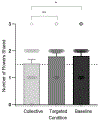No one is going to recess: How children evaluate collective and targeted punishment
- PMID: 38993500
- PMCID: PMC11238698
- DOI: 10.1111/sode.12730
No one is going to recess: How children evaluate collective and targeted punishment
Abstract
This study examined children's responses to targeted and collective punishment. Thirty-six 4-5-year-olds and 36 6-7-year-olds (36 females; 54 White; data collected 2018-2019 in the United States) experienced three classroom punishment situations: Targeted (only transgressing student punished), Collective (one student transgressed, all students punished), and Baseline (all students transgressed, all punished). The older children evaluated collective punishment as less fair than targeted, whereas younger children evaluated both similarly. Across ages, children distributed fewer resources to teachers who administered collective than targeted punishment, and rated transgressors more negatively and distributed fewer resources to transgressors in Collective and Targeted than Baseline. These findings demonstrate children's increasing understanding of punishment and point to the potential impact of different forms of punishment on children's social lives.
Keywords: children; collective punishment; development; fairness; targeted punishment.
Conflict of interest statement
CONFLICT OF INTEREST STATEMENT The authors declare no conflicts of interest.
Figures




Similar articles
-
Are young children's preferences and evaluations of moral and conventional transgressors associated with domain distinctions in judgments?J Exp Child Psychol. 2018 Sep;173:284-303. doi: 10.1016/j.jecp.2018.04.008. Epub 2018 May 14. J Exp Child Psychol. 2018. PMID: 29772455
-
Fairness overrides group bias in children's second-party punishment.J Exp Psychol Gen. 2017 Apr;146(4):485-494. doi: 10.1037/xge0000244. J Exp Psychol Gen. 2017. PMID: 28383989
-
Teacher efficacy and pupil behaviour: the structure of teachers' individual and collective beliefs and their relationship with numbers of pupils excluded from school.Br J Educ Psychol. 2012 Dec;82(Pt 4):564-84. doi: 10.1111/j.2044-8279.2011.02046.x. Epub 2011 Aug 26. Br J Educ Psychol. 2012. PMID: 23025393
-
Children's Perspectives on Fairness and Inclusivity in the Classroom.Span J Psychol. 2022 Nov 2;25:e28. doi: 10.1017/SJP.2022.24. Span J Psychol. 2022. PMID: 36321422 Review.
-
Physical punishment of children by US parents: moving beyond debate to promote children's health and well-being.Psicol Reflex Crit. 2018 Jul 3;31(1):16. doi: 10.1186/s41155-018-0096-x. Psicol Reflex Crit. 2018. PMID: 32026051 Free PMC article. Review.
References
-
- Arbeau KA, Coplan RJ, & Weeks M (2010). Shyness, teacher-child relationships, and socio-emotional adjustment in grade 1. International Journal of Behavioral Development, 34(3), 259–269. 10.1177/0165025409350959 - DOI
-
- Baron AS, & Dunham Y (2015). Representing ‘Us’ and ‘Them’: Building blocks of intergroup cognition. Journal of Cognition and Development, 16(5), 780–801. 10.1080/15248372.2014.1000459 - DOI
Grants and funding
LinkOut - more resources
Full Text Sources
